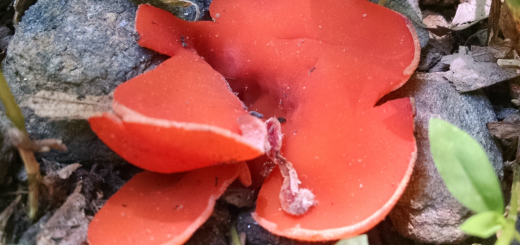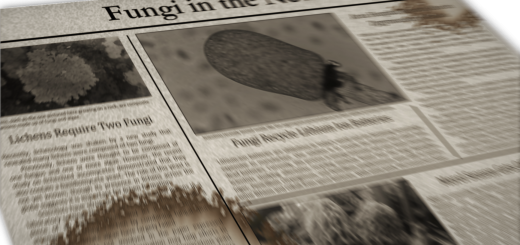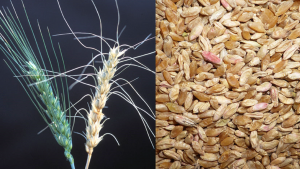#047: Mushroom Morphology: Truffles
Truffles are ascomycetes that form below-ground (hypogeous) fruiting bodies. These mushrooms look like small, lumpy potatoes on the outside. When cut open, truffles have a marbled appearance. Like the false truffles and sequestrate basidiomycetes, true truffles have evolved to retain moisture in arid climates or other harsh conditions. Truffles evolved from cup-shaped ascomycetes with a spore surface exposed to the air. To keep the spores moist, the cup became closed. Eventually, the interior surface became wrinkled and condensed, creating the marbled interior. There are a number of truffle species that exhibit various stages along this evolutionary path. Many of these truffles are hollow on the inside, as the gleba (interior, spore-producing tissue) has not fully become compacted. All truffles rely on animals – usually small mammals – to dig up the fruiting bodies and eat them. Truffles attract these animals by producing various scents. These scents are what give edible truffles their distinctive flavor. The truffle spores pass through the animals’ digestive systems unharmed and are spread to new areas in the animals’
Europe has two species of truffle that are highly prized for their flavor: the French Black/Perigord Truffle (Tuber melanosporum) and the Italian White Truffle (Tuber magnatum). These truffles are some of the most expensive natural foods, regularly fetching from $250 to $500 per pound, sometimes even thousands of dollars a pound. These truffles produce a scent that acts like a male pig’s sex hormone, thus attracting female pigs. For this reason, female pigs are usually used to find truffles in Italy. In France and elsewhere, dogs are more often used. The main benefit of training dogs to find truffles is that the dogs won’t eat the truffles. There are many other species of truffles in Europe and around the world, but most of these are not considered edible by humans. North America has over 50 species of native truffles. Edible truffles in North America include the Oregon White Truffles (Tuber gibbosum and Tuber oregonense) and Pecan/Texas Truffles (Tuber lyonii). The flavor of Oregon White Truffles compares favorably with the European varieties. Oregon White Truffles are found in the Pacific Northwest, where they feed small animals like the northern flying squirrel. At certain times of the year, these and other truffles and false truffles make up over 90% of the diet of small rodents like flying squirrels. Oregon White Truffles also play a crucial role in supporting tree species like the Douglas Fir. The Pecan or Texas Truffles are found east of the Rocky Mountains and support pecan and other trees. These ecosystems, however, are not as dependent upon truffles. Edible truffles can also be found in the desert areas of North Africa and the Middle East. These include Terfezia boudieri, Terfezia pfielli, Terfezia claveryi, and others. Desert truffles can be found beneath the surface after thunderstorms bring precious water to the area. Supposedly, more lightning strikes indicate a better chance of finding these truffles.
When it comes to edibility of truffles, it depends upon the species. Only a few species are edible for humans. Truffles get their desirable taste from volatile scent compounds produced to attract small animals. These scents are only produced after the spores are completely mature, so using an animal is the best way to guarantee that the truffles you find are fully mature. Chinese truffles are often problematic because animals are not used to find them and therefore the truffles are usually harvested before the spores mature. Once picked, truffles rapidly lose their scent. Truffles taste their best immediately after they are picked. They cannot be cooked for very long, as the flavor will quickly evaporate into the air. The result of this would be a very smelly kitchen and bland food. If you can’t get fresh truffles, you can augment the flavor with truffle oil. Because the scent compounds are fat-soluble, oil is often used to retain the flavor. Truffles can also impart flavor to foods like rice and eggs simply by being kept in a confined space (like a glass bottle or refrigerator) with them.
Edible truffles typically come from the genus Tuber (named for the potato-like shape of the fruiting body) or the genus Terfezia. Most truffles are found in phylum Ascomycota, class Pezizomycetes, order Pezizales. The families in this order that have truffle-forming species include: Discinaceae, Elaphomycetaceae, Helvellaceae, Morchellaceae (which also includes morels), Pezizaceae (which includes cup fungi and the genus Terfezia), Pyronemataceae, and Tuberaceae (which includes the genus Tuber). There are a few other truffles that are found in the phylum Ascomycota, class Eurotiomycetes, order Eurotiales, family Elaphomycetaceae, genus Elaphomyces. This diversity means that the truffle morphology has evolved multiple times and the group is polyphyletic. Despite these diverse origins, all truffles are mycorrhizal. This means that they form mutualistic associations with plant species (usually trees). These fungi provide trees with hard-to-get nutrients in exchange for energy in the form of sugar.
See Further:
http://botit.botany.wisc.edu/toms_fungi/jan97.html
If you’re interested in truffles, I recommend exploring the natruffling.org site (the North American Truffling Society’s website), faq page linked below.
http://www.natruffling.org/faq.htm
http://www.mssf.org/cookbook/truffles.html
http://herbarium.usu.edu/fungi/funfacts/truffind.htm
The high value of European truffles has led to the rise of a myco-Mafia, described in the “60 Minutes” article below.
http://www.cbsnews.com/news/truffles-the-most-expensive-food-in-the-world/









![#011: Characteristics of Kingdom Fungi [Archived]](https://www.fungusfactfriday.com/wp-content/themes/hueman/assets/front/img/thumb-small-empty.png)


1 Response
[…] their spores internally and have lost the ability to forcibly discharge their spores. Like the true truffles, false truffles disperse their spores by attracting animals like insects, rodents, and deer. […]